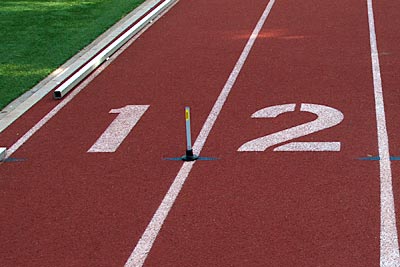Track and field encompasses many disciplines including sprints, hurdles, mid and long distance, jumps, vaults, and throws. High schools track teams are often non-cut sports and the number of students on a team can be as many as two to three hundred. In addition, the track team may have to share the facility with other sports such as soccer or lacrosse. As a result, the track can become quite crowded with many coaches and athletes.
One approach to managing the large number of disciplines is to allocate lanes of the track and/or sections of the track to each coach. For example, the distance coach may be assigned lanes 1 and 2, the girls sprint coach may be assigned the back 100 meters of lanes 3, 4, and 5, and so on. Given the large number of athletes and the complexity and sometimes confusion of the lane assignments, it’s important that the equipment be clearly marked to avoid injury to the athletes and damage to the equipment.
The transmitters of the Freelap Timing System are small and lightweight, making them easy to setup, move, store, and transport. In addition, the transmitters are designed to function on the line between two lanes, and do not require tripods or other support that can take up additional lanes. However, given the relatively small size of the transmitters, it may prove helpful to mark the transmitters with brightly colored cones to make them more obvious.
TX Junior Transmitter Between Lanes 1 and 2.

Figure 1. Tx Junior Transmitter placed on hurdle mark between lanes 1 and 2.
Figure 1 shows a TX Junior transmitter placed on a high-hurdle mark. Figure 2 shows an 18” orange cone being placed directly over the transmitter, and Figure 3 shows the cone set down on the track over the transmitter. Note that because the Freelap transmitters use radio signals to trigger the receiver in each Freelap stopwatch, the transmitters will perform the same with or without the cones placed over them. The bright orange cones will ensure that distracted young athletes are less likely to accidentally step on one of the transmitters.
Cone being placed over TX Junior Transmitter

Figure 2. Cone being placed over TX Junior Transmitter.
Cone and TX Junior Transmitter ready for use.

Figure 3. Canes places next to transmitters.

Figure 4. Cones placed over transmitters.
To summarize, the table below shows the equipment needed to time multiple athletes in the fly-in sprint. For example, timing two athletes requires two Freelap stopwatches and two TX Junior transmitters, and timing four athletes requires four stopwatches and four transmitters.
Athletes |
Watches |
Junior Transmitters |
1 |
1 |
2 |
2 |
2 |
2 |
3 |
3 |
4 |
4 |
4 |
4 |


